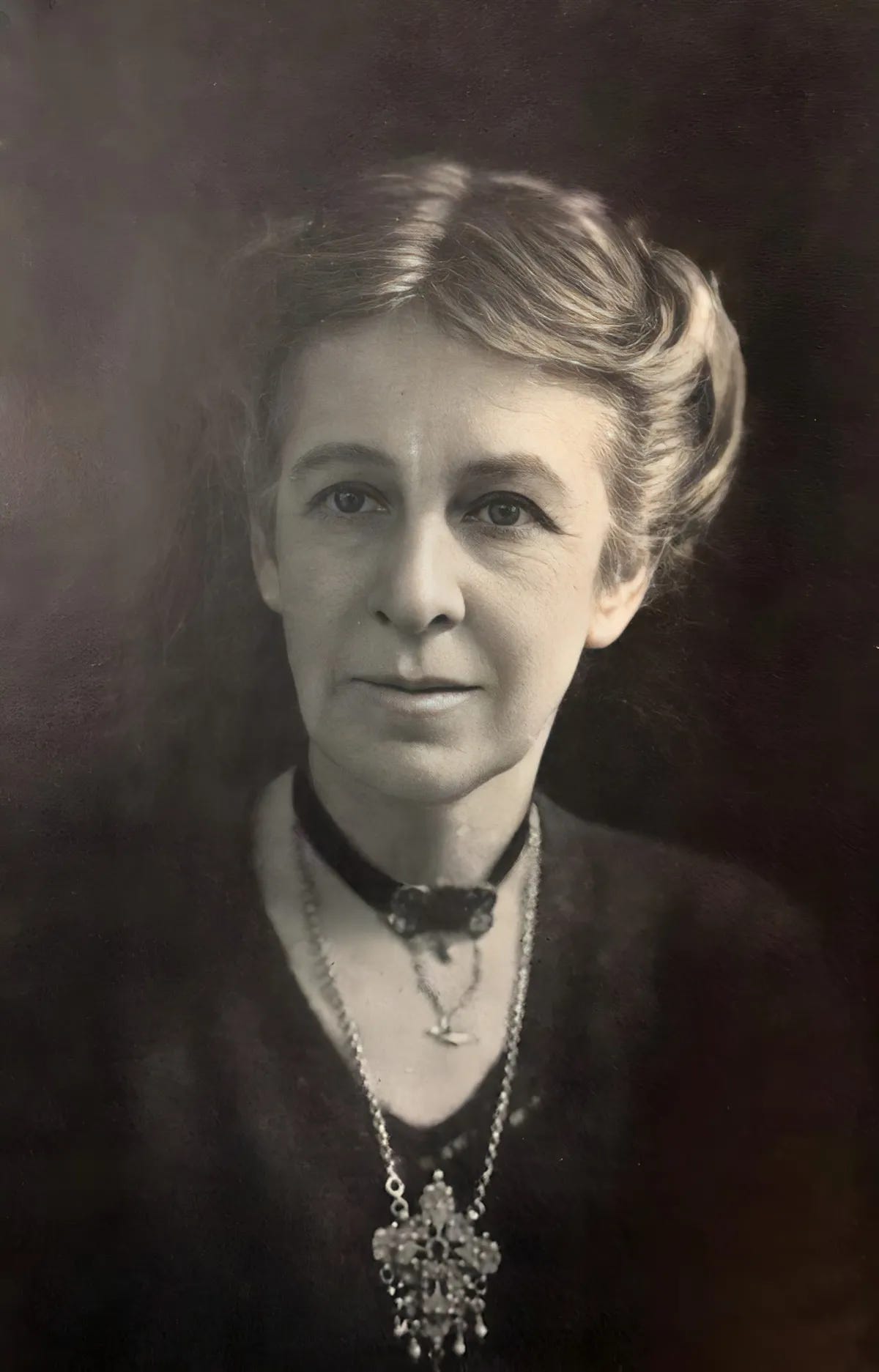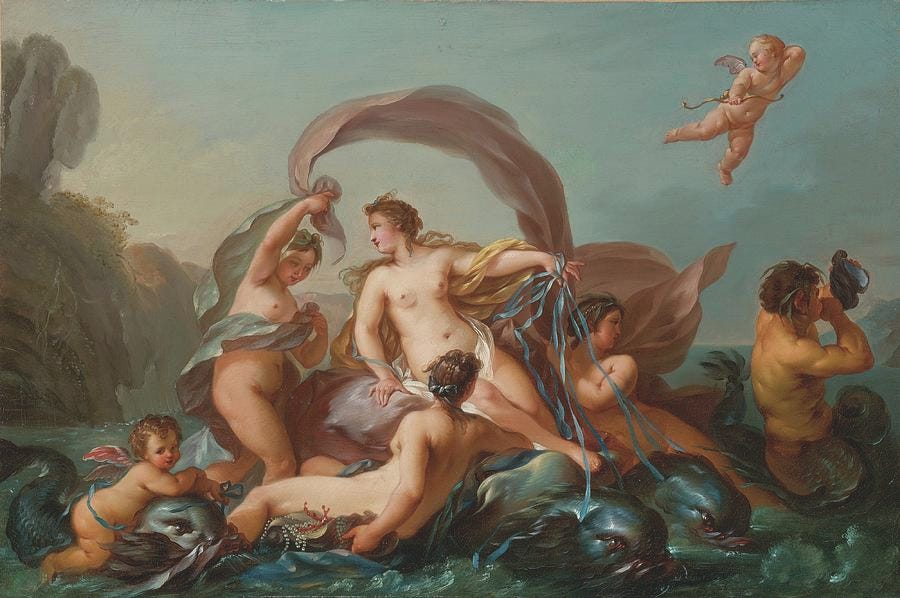The mystic path for people who just need to get dinner on the table AGAIN
Evelyn Underhill's Practical Mysticism
A housekeeping note: I’m going on holiday. Hooray! It’s been a wonderful but intense few months, and I need some time to reflect and decompress, so I’m going to take two weeks off writing these newsletters. I’ve paused billing, so paying subscribers won’t be charged during this time. Thank you for your understanding. Can’t wait to see you on the other side, recharged and full of ideas (and probably chips).
Practical Mysticism is one of those books I wish I’d encountered twenty years ago. If I had, I’m pretty sure it would have saved me years of rolling around in messes of my own making; decades of confusion and lostness.
When she published it, Evelyn Underhill was 39 years old, a prominent English writer on religion and spirituality, a Catholic, and a pacifist. It was 1914, and the world had just descended into World War I.
You might think that the outbreak of a world war would turn a devoted pacifist away from contemplating the great mysteries, towards action on the earthly plane. But for Underhill, war made it more crucial, not less, for all humans to yolk themselves to eternity. She writes in the preface:
We are often told that in the critical periods of history it is the national soul which counts: that “where there is no vision, the people perish.” No nation is truly defeated which retains its spiritual self-possession. No nation is truly victorious which does not emerge with soul unstained. If this be so, it becomes a part of true patriotism to keep the spiritual life, both of the individual citizen and of the social group, active and vigorous; its vision of realities unsullied by the entangled interests and passions of the time.
She goes on to outline, in barely 150 pages, a stunningly incisive, insightful, plain-speaking, and practical guide to living in time with your eyes on eternity. And in case you think this book isn’t for you: Underhill is very clear that the mystic way is not the preserve of medieval anchorites and cave-dwelling hermits. It’s for you and me and all the rest of us just trying to keep on top of our emails and figure out what’s for dinner again. Or, in the language of 1914:
It is to you, practical man, reading these pages as you rush through the Tube to the practical work of rearranging unimportant fragments of your universe, that this message so needed by your time—or rather, by your want of time—is addressed. To you, unconscious analyst, so busy reading the advertisements upon the carriage wall that you hardly observe the stages of your unceasing flight: so anxiously acquisitive of the crumbs that you never lift your eyes to the loaf.
If the tone here sounds patronizing, know that I’ve never found a more open, encouraging, non-judgmental approach to the deepening of the soul than Underhill’s. This book springs from her deep conviction that mystical experience is a universal capacity, and that denying this capacity robs people of the fullness of their humanity and their days.
So what is mysticism, and how do we live it?
The answer to the first question is simple, but not easy. Here’s Underhill’s definition:
Mysticism is the art of union with Reality. The mystic is a person who has attained that union in greater or less degree; or who aims at and believes in such attainment.
Simple! But not easy. Because of course: what is this Reality she speaks of? Well, there’s the rub: in truth, Underhill tells us, it’s something that can’t be explained, only experienced.
Here’s what it isn’t: all the labels, concepts, thoughts, and filters that smear the lenses of our perception, day by day. The ways we select and interpret the world’s infinity and end up living in a simulation—or an “old comfortably upholstered universe”—rather than the rapture of life itself.
No: it’s something that lives before and beyond these things, which can’t be captured in words. (Indeed, many of the smears on our lenses are precisely failed attempts to capture it in words.)
So how do we begin to unite with Reality?
Underhill walks readers through a process that is, again, simple, but not easy. It begins with clearing the lens of the attention, through meditation. This will help us to begin to glimpse things as they are, in the pure white light of their wholeness.
Among the things we’ll see clearly is ourselves—and not the automaton we send out into the world every day, but our true, inmost selves. Meeting this core self and looking clearly at the way we have lived our lives will prompt some uncomfortable reflections. Underhill writes:
It is not merely that your intellect has assimilated, united with a superficial and unreal view of the world. Far worse: your will, your desire, the sum total of your energy, has been turned the wrong way, harnessed to the wrong machine. You have become accustomed to the idea that you want, or ought to want, certain valueless things, certain specific positions. For years your treasure has been in the Stock Exchange, or the House of Commons, or the Salon, or the reviews that “really count” (if they still exist), or the drawing-rooms of Mayfair; and thither your heart perpetually tends to stray. Habit has you in its chains. You are not free.
If this feels like a personal attack, you’re not alone. I’m sweating over here at my lifetime of chasing the reviews that “really count” (if they still exist).
There follows, Underhill tells us, an uncomfortable but quite natural and even inevitable period of self-adjustment, in which you shed old attachments and fixations, seeing clearly now that they don’t serve the flourishing of life—your own or anyone else’s.
And once the cravings of your surface self have quite naturally fallen away, you will have arrived at the life of a practical mystic—a life in which your will is aligned to the highest truth of your eternal self:
Released from the obsessions which so long had governed them, will, heart, and mind are now all bent to the purposes of your deepest being: “gathered in the unity of the spirit,” they have fused to become an agent with which it can act.
Sometimes in life, you discover a body of thought that’s more than thought, to you. It’s a breadcrumb; proof that even if you’re still in the dark woods, you’re walking the right path. Underhill’s work has felt like this, to me. It’s stunning how closely her explanation of mysticism matches my own experience.
Almost four years ago, I stood on a beach in the middle of a pandemic and a divorce, and a wise friend walked me through a series of rituals. She had me wash my wedding ring in the waves, and ask Aphrodite to take away the shame of my failed marriage. When I looked up, still muttering my prayer, a Pacific wave rolled right on inside me, past all the smears on my lens. It showed me the pure white light that all things are made of, and my own eternal self, who had been there all along—who had been there and just fine all along, through even those most painful months of my life.
Since then, without knowing what I was doing—simply putting one foot in front of the other—I’ve begun to live the path Underhill lays out in her book. I’m not there yet, and might never be. Progress, not perfection. But the path itself has been the making of my life.
If any of this has resonated with you, I urge you to get hold of a copy of Practical Mysticism, and read it in full. And if you do that, let me know if it’s a breadcrumb for you, too.
Love,
xx Ellie




Thanks for this amazing intro and digest, I will have a read.
Her book on Mysticism is something of a classical. Dr Joseph Milne recommended it to me at University. He also taught Valentin.